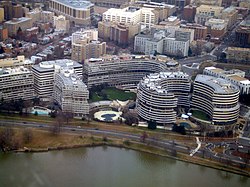Watergate scandal
| Watergate scandal |
|---|

|
| Events |
| People |
The Watergate scandal was a major American political scandal, lasting 1972 through 1974, that issued from the apprehension and arrest of five men in process of burglarizing the Democratic National Committee (DNC) headquarters at the Watergate office complex in Washington, D.C. on June 17, 1972, and the subsequent attempts by President Richard Nixon to cover up any involvement his ad.[41]
No comments:
Post a Comment